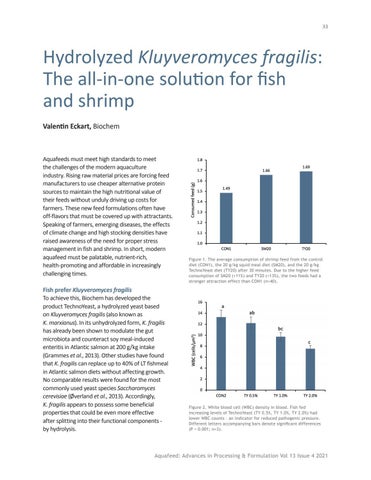33
Hydrolyzed Kluyveromyces fragilis: The all-in-one solution for fish and shrimp Valentin Eckart, Biochem
Aquafeeds must meet high standards to meet the challenges of the modern aquaculture industry. Rising raw material prices are forcing feed manufacturers to use cheaper alternative protein sources to maintain the high nutritional value of their feeds without unduly driving up costs for farmers. These new feed formulations often have off-flavors that must be covered up with attractants. Speaking of farmers, emerging diseases, the effects of climate change and high stocking densities have raised awareness of the need for proper stress management in fish and shrimp. In short, modern aquafeed must be palatable, nutrient-rich, health-promoting and affordable in increasingly challenging times.
Fish prefer Kluyveromyces fragilis To achieve this, Biochem has developed the product TechnoYeast, a hydrolyzed yeast based on Kluyveromyces fragilis (also known as K. marxianus). In its unhydrolyzed form, K. fragilis has already been shown to modulate the gut microbiota and counteract soy meal-induced enteritis in Atlantic salmon at 200 g/kg intake (Grammes et al., 2013). Other studies have found that K. fragilis can replace up to 40% of LT fishmeal in Atlantic salmon diets without affecting growth. No comparable results were found for the most commonly used yeast species Saccharomyces cerevisiae (Øverland et al., 2013). Accordingly, K. fragilis appears to possess some beneficial properties that could be even more effective after splitting into their functional components by hydrolysis.
Figure 1. The average consumption of shrimp feed from the control diet (CON1), the 20 g/kg squid meal diet (SM20), and the 20 g/kg TechnoYeast diet (TY20) after 30 minutes. Due to the higher feed consumption of SM20 (+11%) and TY20 (+13%), the two feeds had a stronger attraction effect than CON1 (n=40).
Figure 2. White blood cell (WBC) density in blood. Fish fed increasing levels of TechnoYeast (TY 0.5%, TY 1.0%, TY 2.0%) had lower WBC counts – an indicator for reduced pathogenic pressure. Different letters accompanying bars denote significant differences (P < 0.001; n=3).
Aquafeed: Advances in Processing & Formulation Vol 13 Issue 4 2021









